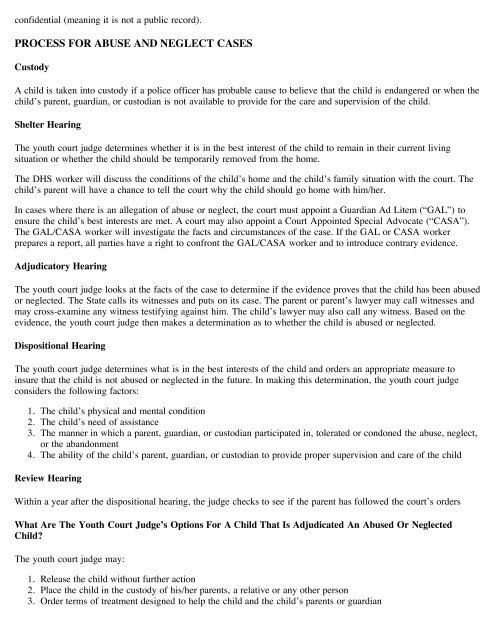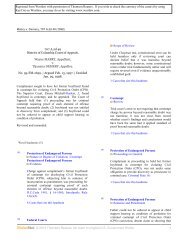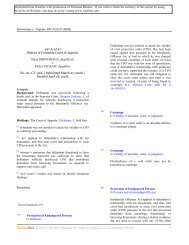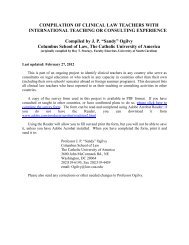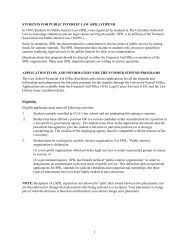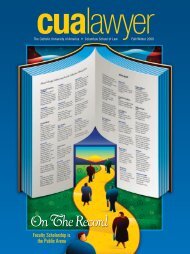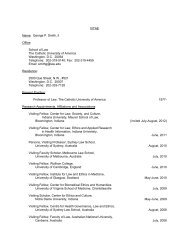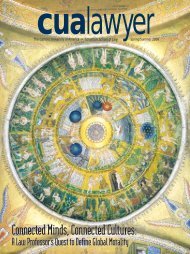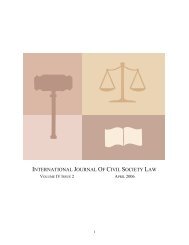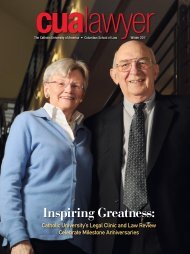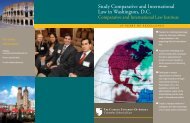Hurricane Katrina: Legal Issues - Columbus School of Law
Hurricane Katrina: Legal Issues - Columbus School of Law
Hurricane Katrina: Legal Issues - Columbus School of Law
You also want an ePaper? Increase the reach of your titles
YUMPU automatically turns print PDFs into web optimized ePapers that Google loves.
confidential (meaning it is not a public record).<br />
PROCESS FOR ABUSE AND NEGLECT CASES<br />
Custody<br />
A child is taken into custody if a police <strong>of</strong>ficer has probable cause to believe that the child is endangered or when the<br />
child’s parent, guardian, or custodian is not available to provide for the care and supervision <strong>of</strong> the child.<br />
Shelter Hearing<br />
The youth court judge determines whether it is in the best interest <strong>of</strong> the child to remain in their current living<br />
situation or whether the child should be temporarily removed from the home.<br />
The DHS worker will discuss the conditions <strong>of</strong> the child’s home and the child’s family situation with the court. The<br />
child’s parent will have a chance to tell the court why the child should go home with him/her.<br />
In cases where there is an allegation <strong>of</strong> abuse or neglect, the court must appoint a Guardian Ad Litem (“GAL”) to<br />
ensure the child’s best interests are met. A court may also appoint a Court Appointed Special Advocate (“CASA”).<br />
The GAL/CASA worker will investigate the facts and circumstances <strong>of</strong> the case. If the GAL or CASA worker<br />
prepares a report, all parties have a right to confront the GAL/CASA worker and to introduce contrary evidence.<br />
Adjudicatory Hearing<br />
The youth court judge looks at the facts <strong>of</strong> the case to determine if the evidence proves that the child has been abused<br />
or neglected. The State calls its witnesses and puts on its case. The parent or parent’s lawyer may call witnesses and<br />
may cross-examine any witness testifying against him. The child’s lawyer may also call any witness. Based on the<br />
evidence, the youth court judge then makes a determination as to whether the child is abused or neglected.<br />
Dispositional Hearing<br />
The youth court judge determines what is in the best interests <strong>of</strong> the child and orders an appropriate measure to<br />
insure that the child is not abused or neglected in the future. In making this determination, the youth court judge<br />
considers the following factors:<br />
1.<br />
The child’s physical and mental condition<br />
2.<br />
The child’s need <strong>of</strong> assistance<br />
3.<br />
The manner in which a parent, guardian, or custodian participated in, tolerated or condoned the abuse, neglect,<br />
or the abandonment<br />
4.<br />
The ability <strong>of</strong> the child’s parent, guardian, or custodian to provide proper supervision and care <strong>of</strong> the child<br />
Review Hearing<br />
Within a year after the dispositional hearing, the judge checks to see if the parent has followed the court’s orders<br />
What Are The Youth Court Judge’s Options For A Child That Is Adjudicated An Abused Or Neglected<br />
Child?<br />
The youth court judge may:<br />
1.<br />
Release the child without further action<br />
2.<br />
Place the child in the custody <strong>of</strong> his/her parents, a relative or any other person<br />
3.<br />
Order terms <strong>of</strong> treatment designed to help the child and the child’s parents or guardian


